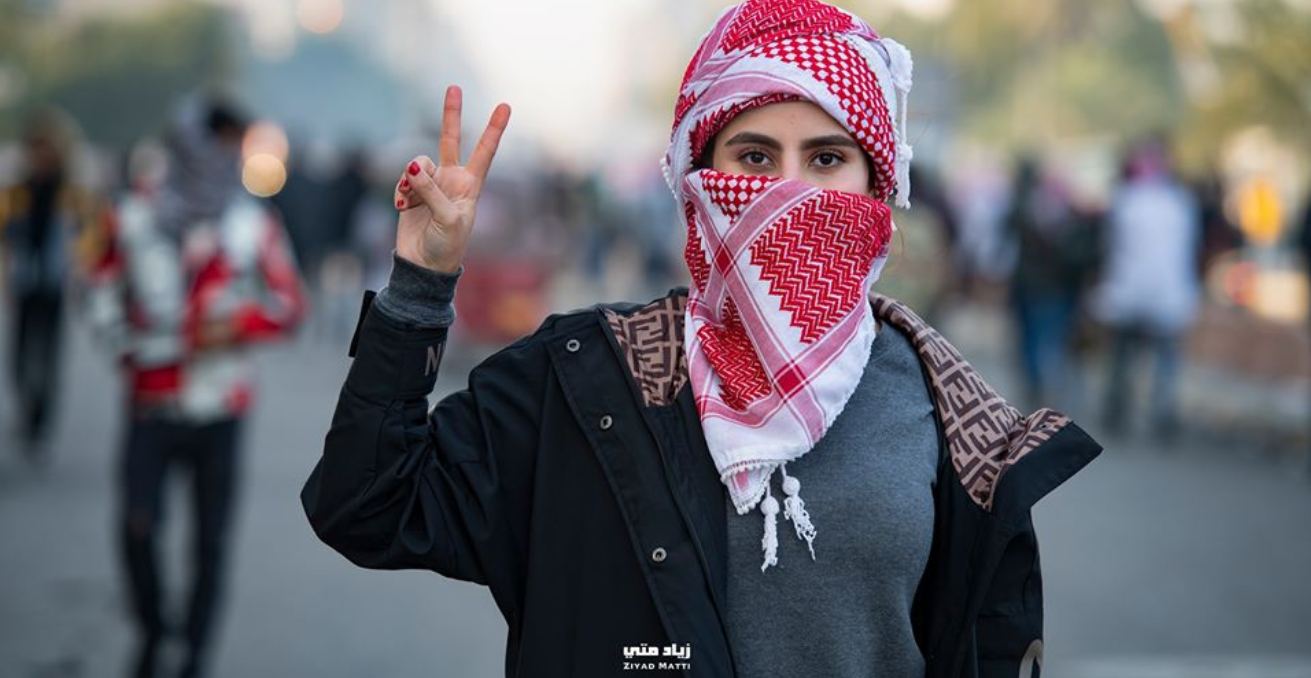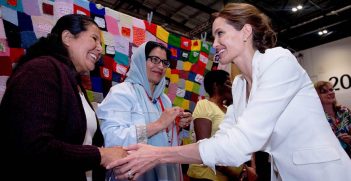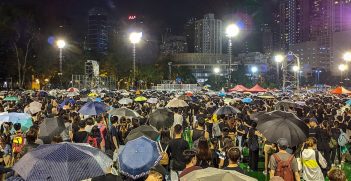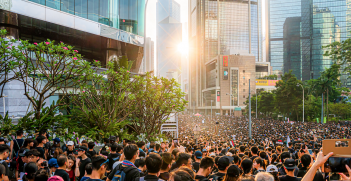The Pink and Purple Protest: Iraqi Women Invert the Gender Game

Women are promoting, mobilising, and leading social movements around the globe. In Iraq, women directly confront deeply-rooted traditional and religious gender norms despite very real threats of violence.
On 8 February 2020, Mukqtada Al-Sadr, the Shi’a cleric, leader of the Saraya Al-salam militia, the Sadrist Movement, and an influential figure in the political and social life in Iraq tweeted what he called “The Pact of the Reform Revolution.” He listed 18 items that he urged not only his followers but all Iraqi people to implement in protest squares and demonstration zones. Among these behests is number nine, which says: “The Shari’a rules and social codes of this country must be taken into consideration, the mix between genders inside the protests’ tents is not acceptable and that the protests’ zones must be clear from drugs, alcohol or any other type of inebriants.” The tweet delimited the religious background of the protestors to Muslims only. It disparaged women’s involvement in the protest by discrediting them and limiting their participation in shared tents with male protestors.
Responding to this regressive tweet, hundreds of thousands of Iraqi women marched on 13 February in Iraqi cities, including Baghdad, Al-Basrah, Thi-Qar, Karbala, Babylon, and Al-Najaf city, the birthplace of Al-Sadr and the religious centre of Shi’a in the world. Protesters carried signs with slogans such as, “If you use your ammunition, I will use my determination” and “We are the nation, who are you? I am a revolution.” Hashtags of the Purple and Pink Protest quickly circulated. The most trending were بناتك_يا-وطن# (the daughters of the nation) and صوتج_ثورة_مو_عورة# (your voice is a revolution, it is never an indecent act). The “voice” here refers to women’s participation, recognition, and visibility in the Iraqi protests that started on 1 October 2019.
Women from various backgrounds and across generations and political orientations protested wearing gender-coded colours: pink and purple. Some wore purple or pink head-covers. Others put on jackets or coats or shawls. The majority wore pink or purple Yashmagh, popular head-top pieces traditionally part of men’s outfits in several MENA countries and also worn by Kurds and Arabs.
The female protesters’ clever performative act, blending feminine colours with the masculine Yashmagh, has brought in one piece of cloth a reference to both genders. Iraqi women and men in their plural performativity have composed a singular lobby for social, economic, and political justice.
The Pink and Purple Protest came to highlight that women led resistance committees and sit-ins, planned protest routes, and disobeyed curfews. They stayed overnight in protest tents, violating the deep-rooted disapproval in Iraq of women staying overnight in public places. Even in the midst of a declared state of emergency that left women vulnerable to attacks by security forces, women protested in streets and squares. Many were teargassed, threatened, assaulted, abducted, and in some cases, killed.
Female activists who were abducted include Saba Al Mahdawi, Mary Mohammed, Ayat Al-Marsumi, Khulud Al-Ta’ee, and most recently, Rana Alsumaidai, a prominent member in Sadrist movement who described on Twitter how she was kidnapped by the Al-Sadr militia because of her opposition to Al-Sadr’s suppressive approach to the protesters. Zahraa Ali Alqaraloosi, a 19-year old participant from a Kurd Faili background whose family lives in Baghdad, was found dead in front of her house on the 2 December 2019. Sara Talib, her husband Hussein Adel, and their four-year old daughter were killed by militia members in Al-Basra. Sara was an activist and a field nurse.
In protest zones, women are also cooking food or providing homemade meals. They are washing protestors’ clothes and attending to the wounded. They are praying, which is not acceptable for women to do in public and open spaces. Islam sets clear binaries between private and public spaces for religious practices specifically for women. Praying in public signifies women’s ability to cross religious and traditional norms.
Iraqi women are active on social media and have been posting live streams from Tahrir Square in Baghdad and Al-Haboby Square in Thi-Qar Al-Nasriyah. This is precarious as these women are easily traced and targeted by security forces. Activists on social media play a significant role as they documented the brutality against unarmed protesters.
“Artivism” is a new trajectory of visibility for Iraqi women protestors. A number of female artists and activists have utilized public spaces to spread their message, painting on walls and security blocks that isolate Al-Tahrir Square. They also played music which, until recently, was considered Haram (forbidden) by many conservatives and religious clerics. They composed and read poetry and created a newspaper called TukTuk. Female lawyers and solicitors organised discussion circles to spread awareness of the rights of freedom of expression protected in Article 19 of the Iraqi constitution.
Women’s visibility in the protest is not limited to logistically supporting male protesters, going way beyond the cultural, social, and religious legacies. Women’s field involvement comes at a political moment that is described as hyper-militarian, hyper-sectarian, hypermasculine, and patriarchal. Hence, women’s involvement in the Iraqi protest needs to be read according to four main contexts: temporal, spatial, political, and social. First, as the protests started on 1 October, nearly five months ago, women’s participation has been continuous rather than episodic. Second, as these protest acts take place in open spaces and public places, where women are easily detected, traced, and targeted. Their visibility in these spaces is the reason for their vulnerability. Third, the protests are anti-government so there is no official support. On the contrary, women are being recognised as troublemakers and disobedient. Finally, there has been a clear backlash towards women’s social recognition. Iraqi women are subjected to patriarchal custody through the powerful role of the tribe and the sect over women’s daily life activities. So, these women protesters are taboo-breakers. They have been accused of infidelity, their family names have been dishonored, and even referred to with pejorative references, such as “prostitutes” or “the whores of the nation.”
Despite the fears, intimidation, and abductions, the Pink and Purple Protest suggests women’s hyper-visibility is what women want, rather than recognition by politicians, clerics, or male family members. So, it invites a break with this politico-tribo-sectarian triangle that has regulated gender norms and Islamicised and sectarianised women’s identity and social recognition.
It is important to situate the Pink and Purple Protest with other protests promoted by women in the MENA region, such as in Lebanon, Algeria, Iran. Alaa Saleh is aniconic figure who has helped fuel Sudanese protests through her fierce speech, prose, and performance . It is also important to position these social movements on the big canvas of the fourth wave of feminism, as the globe is seething in anger over violence against women in Chile, Brazil, Hong Kong, and India.
Women do not ask for their rights to be given. They demand these rights through their visibility in protest zones. They are not part of the protests – they are the protest, they are the revolution.
Dr Hadeel Abdelhameed is an Honorary Academic Staff at the La Trobe University School of Humanities and Social Sciences. Her esearch interests include cultural representation of remote wars and inner conflicts, Iraqi women post 2003, Australian women in recent wars, gender codes in war-torn zones, and women’s rights.
This article is published under a Creative Commons Licence and may be republished with attribution.





